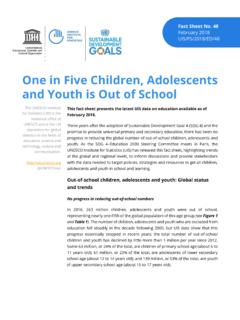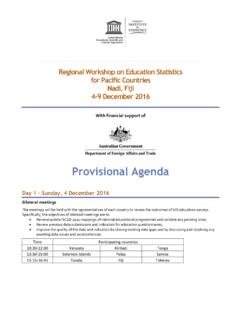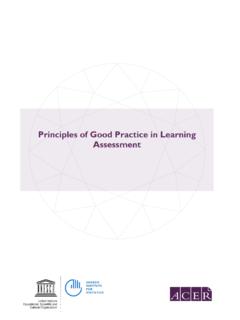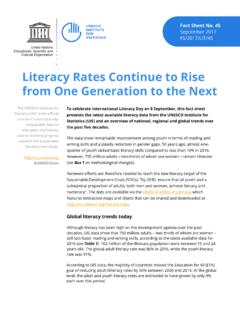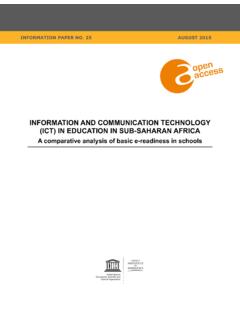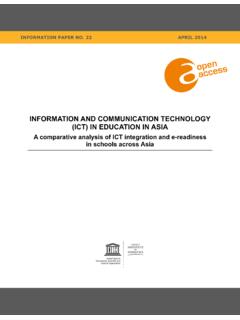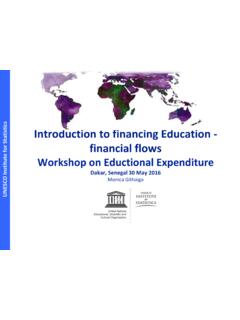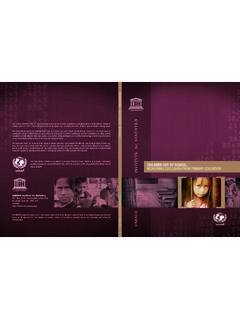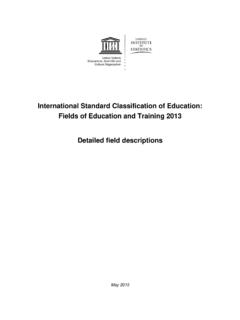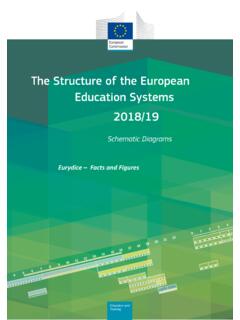Transcription of SSI International Standard Classification of education IC ...
1 2695 Since education systems vary in structure and content across countries, the International Standard Classification of education ( isced ) provides the framework for presenting data in a comparable and uniform manner. It facilitates the transformation of national education data into internationally agreed categories that make cross-national comparisons is a reference Classification within the United Nations International Family of Economic and Social Classifications. First developed by UNESCO in the 1970s, it has been updated periodically to reflect the ongoing evolution of education systems around the world. As such, the new isced 2011 Classification (which replaces isced 1997) provides improved definitions and a greater scope to better monitor global patterns in education . To this end, the sections on tertiary and early childhood education have been substantially revised.
2 In addition, isced 2011 presents new coding schemes for education programmes and educational UNESCO Institute for Statistics (UIS) is the custodian of isced , responsible for its development, maintenance, updating and revision. The Institute provides guidance on the effective and consistent use of isced for International data collection and analysis. The UNESCO Institute for Statistics (UIS) is the statistical office of the United Nations Educational, Scientific and Cultural Organization (UNESCO) and is the UN depository for internationally comparable statistics in the fields of education , science and technology, culture and 2011 International Standard Classification of education ( isced ) 2011uneSCo InStItute for StatIStICS International Standard Classification of educationInternational Standard Classification of EducationISCED 2011 UNESCOThe constitution of the United Nations Educational, Scientific and Cultural Organization (UNESCO) was adopted by 20 countries at the London Conference in November 1945 and entered into effect on 4 November 1946.
3 The Organization currently has 195 Member States and 8 Associate Members. The main objective of UNESCO is to contribute to peace and security in the world by promoting collaboration among nations through education , science, culture and communication in order to foster universal respect for justice, the rule of law, and the human rights and fundamental freedoms that are affirmed for the peoples of the world, without distinction of race, sex, language or religion, by the Charter of the United fulfil its mandate, UNESCO performs five principal functions: 1) prospective studies on education , science, culture and communication for tomorrow s world; 2) the advancement, transfer and sharing of knowledge through research, training and teaching activities; 3) Standard -setting actions for the preparation and adoption of internal instruments and statutory recommendations.
4 4) expertise through technical co-operation to Member States for their development policies and projects; and 5) the exchange of specialized is headquartered in Paris, Institute for StatisticsThe UNESCO Institute for Statistics (UIS) is the statistical office of UNESCO and is the UN depository for global statistics in the fields of education , science and technology, culture and UIS was established in 1999. It was created to improve UNESCO s statistical programme and to develop and deliver the timely, accurate and policy-relevant statistics needed in today s increasingly complex and rapidly changing social, political and economic UIS is based in Montreal, in 2012 by:UNESCO Institute for Statistics Box 6128, Succursale Centre-Ville Montreal, Quebec H3C 3J7 CanadaTel: (1 514) 343-6880 Email: 978-92-9189-123-8 Ref: UIS/2012/INS/10/REVG raphic design: JCNicholls / UNESCO-UIS 2012 FOREWORDAs national education systems vary in terms of structure and curricular content, it can be difficult to benchmark performance across countries over time or monitor progress towards national and International goals.
5 In order to understand and properly interpret the inputs, processes and outcomes of education systems from a global perspective, it is vital to ensure that data are comparable. This can be done by applying the International Standard Classification of education ( isced ), the Standard framework used to categorise and report cross-nationally comparable education isced 2011 Classification was adopted by the UNESCO General Conference at its 36th session in November 2011. Initially developed by UNESCO in the 1970s, and first revised in 1997, the isced Classification serves as an instrument to compile and present education statistics both nationally and internationally. The framework is occasionally updated in order to better capture new developments in education systems worldwide. isced 2011 includes improved definitions for types of education and clarifies their application to isced .
6 Categories have been added to the Classification of levels in recognition of the expansion of early childhood education and restructuring of tertiary education . New features also include: i) the introduction of educational qualifications as a related statistical unit alongside the education programme; ii) three-digit coding schemes for the levels of education programmes and educational attainment; iii) a section on isced governance; and iv) an expanded glossary. These improvements were introduced by a global technical advisory panel, comprising International experts on education and statistics including relevant International organizations and partners, such as Eurostat and the Organisation for Economic Co-operation and Development (OECD). The extensive review process included a series of regional expert meetings and a formal global consultation coordinated by the UNESCO Institute for Statistics (UIS) in which all UNESCO Member States were invited to take part.
7 The UIS and UNESCO-OECD-Eurostat (UOE) data collection programmes will be adjusted according to these new standards. Member States will apply isced 2011 in the reporting of their education statistics starting in 2011 will contribute to the production of even more reliable and comparable International statistics on education , reflecting the ongoing evolution of education systems 2012 Hendrik van der Pol DirectorUNESCO Institute for StatisticsiiiISCED 2011 TABLE OF CONTENTSS ection 1. What is isced ? .. 6 Section 2. Unit of Classification ..7 Section 3. Programmes spanning isced levels, sequential programmes and modular programmes ..9 Section 4. Scope of education in isced ..11 Section 5. Cross- Classification variables ..13 Section 6. Types of data ..19 Section 7. Coding schemes ..21 Section 8. Governance ..23 Section 9.
8 isced levels ..25 isced level 0 Early childhood education ..26 isced level 1 Primary education ..30 isced level 2 Lower secondary education ..33 isced level 3 Upper secondary education ..38 isced level 4 Post-secondary non-tertiary education ..43 Tertiary education ..46 isced level 5 Short-cycle tertiary education ..48 isced level 6 Bachelor s or equivalent level ..51 isced level 7 Master s or equivalent level ..55 isced level 8 Doctoral or equivalent level ..59 Section 10. Correspondence between isced 2011 and isced 1997 levels ..62 Annex I. isced 2011 potential educational pathways ..68 Annex II. Coding of education programmes ..69 Annex III. Coding of educational attainment ..71 Annex IV. Broad groups and fields of education ..73 Annex V. Non-formal education in isced : Further issues ..76 Annex VI. Glossary.
9 78vISCED 20116 SECTION 1 WHAT IS isced ? 1. The International Standard Classification of education ( isced ) belongs to the United Nations International Family of Economic and Social Classifications, which are applied in statistics worldwide with the purpose of assembling, compiling and analysing cross-nationally comparable data. isced is the reference Classification for organizing education programmes and related qualifications by education levels and fields. isced is a product of International agreement and adopted formally by the General Conference of UNESCO Member isced is designed to serve as a framework to classify educational activities as defined in programmes and the resulting qualifications into internationally agreed categories. The basic concepts and definitions of isced are therefore intended to be internationally valid and comprehensive of the full range of education isced classifies education programmes by their content using two main cross- Classification variables: levels of education (see Section 9) and fields of education (see Annex IV).
10 isced 2011 presents a revision of the isced 1997 levels of education Classification . It also introduces a related Classification of educational attainment levels based on recognised educational qualifications. 4. Information compiled according to isced can be used for assembling statistics on many different aspects of education of interest to policymakers and other users of International education statistics. These aspects include enrolment and attendance, human or financial resources invested in education , and the educational attainment of the The application of isced facilitates the transformation of detailed national education statistics on participants, providers and sponsors of education , compiled on the basis of national concepts and definitions, into aggregate categories that can be compared and interpreted Data collections of education statistics assembled according to isced can be based on different data sources such as administrative registers, individual and household surveys, and macro-economic aggregated statistics.
